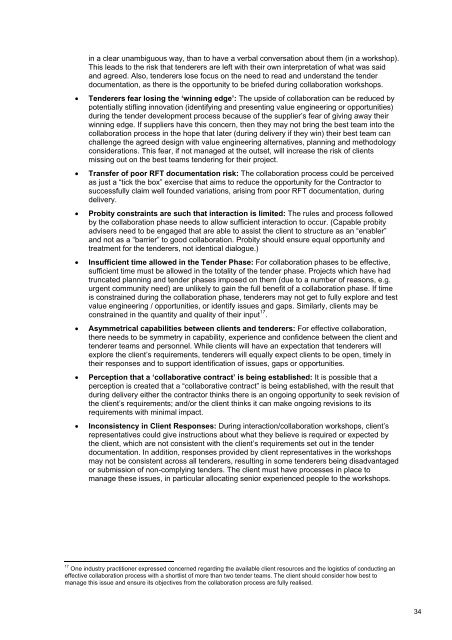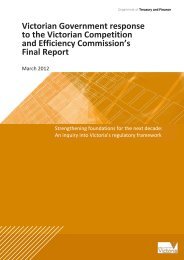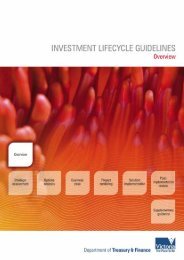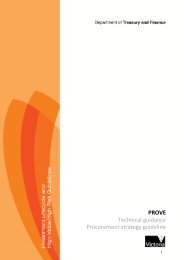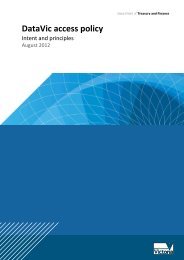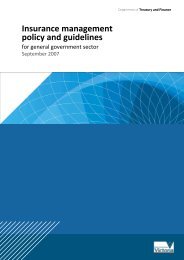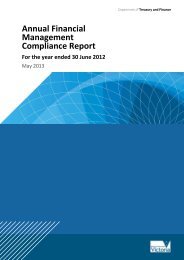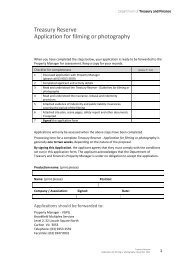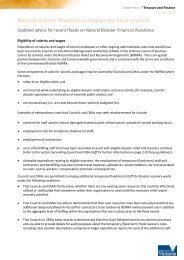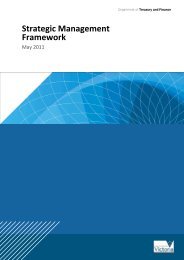Towards Agreed Expectations - Department of Treasury and Finance
Towards Agreed Expectations - Department of Treasury and Finance
Towards Agreed Expectations - Department of Treasury and Finance
Create successful ePaper yourself
Turn your PDF publications into a flip-book with our unique Google optimized e-Paper software.
in a clear unambiguous way, than to have a verbal conversation about them (in a workshop).This leads to the risk that tenderers are left with their own interpretation <strong>of</strong> what was said<strong>and</strong> agreed. Also, tenderers lose focus on the need to read <strong>and</strong> underst<strong>and</strong> the tenderdocumentation, as there is the opportunity to be briefed during collaboration workshops.Tenderers fear losing the ‘winning edge’: The upside <strong>of</strong> collaboration can be reduced bypotentially stifling innovation (identifying <strong>and</strong> presenting value engineering or opportunities)during the tender development process because <strong>of</strong> the supplier’s fear <strong>of</strong> giving away theirwinning edge. If suppliers have this concern, then they may not bring the best team into thecollaboration process in the hope that later (during delivery if they win) their best team canchallenge the agreed design with value engineering alternatives, planning <strong>and</strong> methodologyconsiderations. This fear, if not managed at the outset, will increase the risk <strong>of</strong> clientsmissing out on the best teams tendering for their project.Transfer <strong>of</strong> poor RFT documentation risk: The collaboration process could be perceivedas just a “tick the box” exercise that aims to reduce the opportunity for the Contractor tosuccessfully claim well founded variations, arising from poor RFT documentation, duringdelivery.Probity constraints are such that interaction is limited: The rules <strong>and</strong> process followedby the collaboration phase needs to allow sufficient interaction to occur. (Capable probityadvisers need to be engaged that are able to assist the client to structure as an “enabler”<strong>and</strong> not as a “barrier” to good collaboration. Probity should ensure equal opportunity <strong>and</strong>treatment for the tenderers, not identical dialogue.)Insufficient time allowed in the Tender Phase: For collaboration phases to be effective,sufficient time must be allowed in the totality <strong>of</strong> the tender phase. Projects which have hadtruncated planning <strong>and</strong> tender phases imposed on them (due to a number <strong>of</strong> reasons, e.g.urgent community need) are unlikely to gain the full benefit <strong>of</strong> a collaboration phase. If timeis constrained during the collaboration phase, tenderers may not get to fully explore <strong>and</strong> testvalue engineering / opportunities, or identify issues <strong>and</strong> gaps. Similarly, clients may beconstrained in the quantity <strong>and</strong> quality <strong>of</strong> their input 17 .Asymmetrical capabilities between clients <strong>and</strong> tenderers: For effective collaboration,there needs to be symmetry in capability, experience <strong>and</strong> confidence between the client <strong>and</strong>tenderer teams <strong>and</strong> personnel. While clients will have an expectation that tenderers willexplore the client’s requirements, tenderers will equally expect clients to be open, timely intheir responses <strong>and</strong> to support identification <strong>of</strong> issues, gaps or opportunities.Perception that a ‘collaborative contract’ is being established: It is possible that aperception is created that a “collaborative contract” is being established, with the result thatduring delivery either the contractor thinks there is an ongoing opportunity to seek revision <strong>of</strong>the client’s requirements; <strong>and</strong>/or the client thinks it can make ongoing revisions to itsrequirements with minimal impact.Inconsistency in Client Responses: During interaction/collaboration workshops, client’srepresentatives could give instructions about what they believe is required or expected bythe client, which are not consistent with the client’s requirements set out in the tenderdocumentation. In addition, responses provided by client representatives in the workshopsmay not be consistent across all tenderers, resulting in some tenderers being disadvantagedor submission <strong>of</strong> non-complying tenders. The client must have processes in place tomanage these issues, in particular allocating senior experienced people to the workshops.17One industry practitioner expressed concerned regarding the available client resources <strong>and</strong> the logistics <strong>of</strong> conducting aneffective collaboration process with a shortlist <strong>of</strong> more than two tender teams. The client should consider how best tomanage this issue <strong>and</strong> ensure its objectives from the collaboration process are fully realised.34


